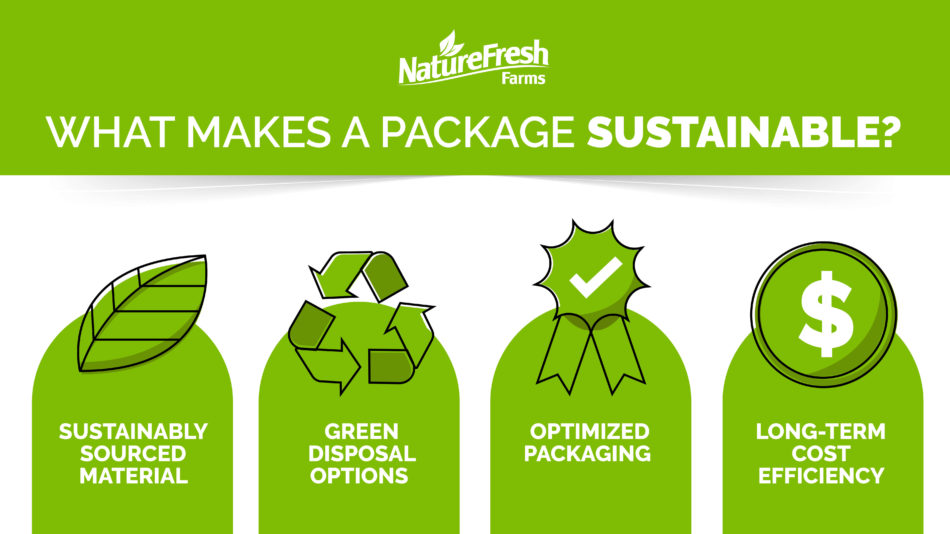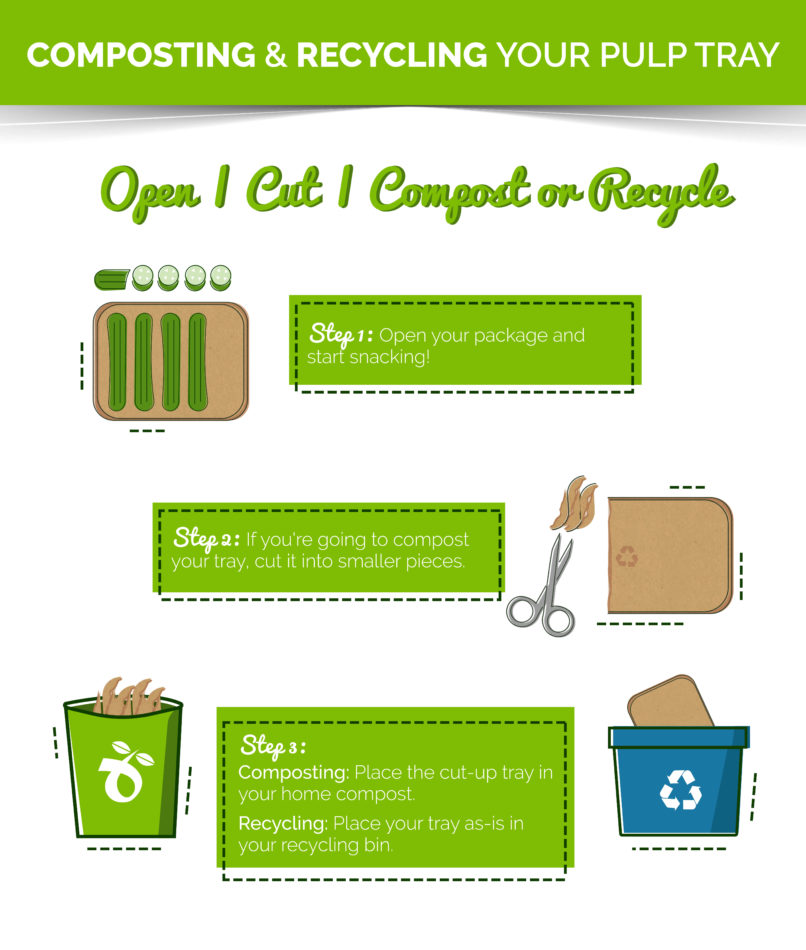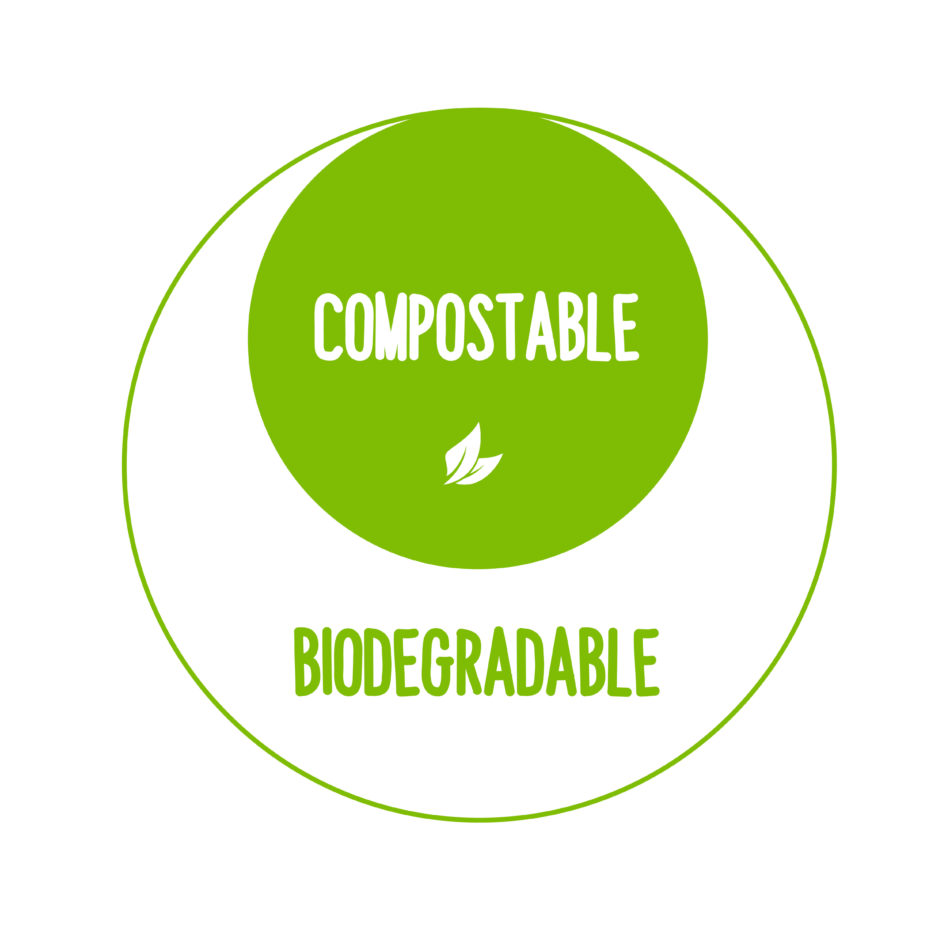The Importance of Sustainable Packaging
Packaging plays an important role in fresh produce: it extends shelf life, ensures food safety standards are met, and reduces food waste. But there are often opportunities for packaging to be improved, especially when it comes to its impact on the environment.
Our team believes in taking a holistic approach when developing new packaging concepts. If a new package helps us deliver quality produce while also reducing our impact on the environment, we consider it a win for our company, our consumers, and our planet!
As the need for more sustainable packaging options grows, our team continues to research, trial, and implement innovative packaging solutions that strike a balance between being good for both our customers and for the environment. But what is equally important is ensuring everyone throughout the supply chain – from our Warehouse team to our end-consumers – have the knowledge they need to make educated decisions about the proper use and disposal of sustainable packaging.
While we explore the concept of sustainable packaging and discuss why it is so important within fresh produce, we will refer to our compostable pulp-molded tray as a successful case study. This tray took close to a year to fully develop before being introduced to the marketplace, and since its introduction, the pulp tray program has saved, to date, around 80,000 pounds of Styrofoam trays from entering landfills! This is a great success story that shows the impact a sustainable package can have when its development has been thoughtful and strategic.
What is Sustainable Packaging?
Many people are asking this important question: what makes a package sustainable? The answer is not as complicated as you may think.
To be considered sustainable, a packaging concept should meet these four criteria:
- The material is sourced sustainably
- The disposal options support recycling and/or composting
- The design is optimized for maintaining product quality
- The cost of production is feasible for long-term application
Let’s take an in-depth look at these four criteria.

Sustainably Sourced Material
A sustainably sourced material is sourced in a way that is environmentally and socially responsible, renewable, and/or made from recycled content. There are many different packaging materials that can be sourced sustainably. One example is corrugated boxes that are made from material supplied by a certified fiber sourcing program. No matter what shape or size, these are the types of boxes we use here at Nature Fresh Farms for the shipment of our products.
Looking specifically at our compostable pulp-molded tray, the material used to create this tray is paper-based. The supplier we worked with to develop the tray uses 100% post-industrial paper waste which has been ground up and mixed with water, creating a pulp-based material. Not only is the material sourced sustainably from post-industrial paper waste, the pulp tray also releases no toxic or hazardous chemicals into the environment during decomposition.
Green Disposal Options
When the disposal options for a package support recycling or composting, it is considered a sustainable packaging solution; this is because recycling and composting are two environmentally responsible end-of-life options for waste disposal. With their popularity growing, recyclable and compostable materials are becoming more and more common to incorporate into packaging concepts. At Nature Fresh Farms, we are always designing and reassessing our packages to be optimized for both recyclability and compostability. For example, many of our bags we pack our produce in have been converted from multi-material pouches to single material pouches, drastically increasing their recyclability.
However, it is just as important that the proper disposal of sustainable packaging is communicated to the end-consumer in a clear, accessible way. A strong example of this is when our team added the universally recognized recycling symbol to our recyclable packaging, ensuring consumers know exactly how to dispose of our packaging products in a responsible way. With access to this vital information, people become empowered to do their part and take responsibility for their disposal decisions.
Looking back to our pulp-molded compostable tray, consumers can clearly see the well-recognized recycling symbol on the bottom of the tray. Although this does not apply to all paper-based products, we want to ensure our consumers understand that this pulp-molded tray is both recyclable and compostable!

The Difference Between Compostable & Biodegradable
There is currently a lot of discussion around compostable and biodegradable materials. It is important to state the distinction between these two classifications as they are not equal and do not mean the same thing.

Compostable material decomposes at a rate that is comparable to other known compostable materials, and through standard testing, it is proven to leave no visible residue during the decomposition process.
Biodegradable material will eventually break down into smaller and smaller pieces, but the rate of biodegradation is dependent on the type of material. Also, biodegradable materials may release toxic components during the biodegradation process. Keeping this definition in mind, almost anything can be classified as ‘biodegradable’ as most materials will eventually break down – but while some materials may break down in 6 months, others may take 1000 years!
Compostable and biodegradable do not mean the same thing, so it is important for all of us to pay close attention to packaging labels to ensure we make proper and responsible end-of-life disposal decisions.
Optimized Packaging
It is one thing for packaging to be made from sustainable materials and recyclable or compostable – it’s another thing for the design of that packaging to also extend product shelf life and ensure food safety standards are upheld!
One of the most important aspects of packaging design is ensuring our products are protected at every level of the supply chain. Many produce items need to be shielded from external elements, protected during transport, and kept fresh for as long as possible, which means optimized packaging plays an extremely important role in ensuring product quality, safety, and freshness.
Limiting unnecessary packaging, which refers to excess packaging materials that do not help extend a product’s shelf life or ensure product quality, is another important part of optimizing packaging design. Reductions in packaging size and material usage allow our team to make more responsible decisions about the packaging products we introduce to the marketplace. We have recently taken the initiative to limit unnecessary packaging on our 6-pack Rainbow Bell Pepper bag, shortening the height of the bag to limit the amount of recyclable plastic used.
Our compostable pulp-molded tray has been optimally designed to ensure maximum product quality, safety, and shelf life longevity. When testing the tray’s performance in each of these categories, it was important for our team to consider what challenges the package might face throughout the supply chain. We asked questions like:
- How durable does the tray have to be in order to keep the product protected during transport?
- How thick does the tray need to be to keep our products securely packed?
- How long does it take for the tray to start breaking down?
Once these important questions were asked, we were able to optimize the final package design for peak performance.
Long-term Cost Efficiency
A package can be made from sustainably sourced material, be supported by recycling or composting, and have an optimized design, but if its cost of production is too high, it cannot be a sustainable solution for the long term. Cost can often be an overlooked aspect of packaging development, but it is also one of the most important factors that can make or break the successful launch of an innovative packaging concept.
While the cost of production for our compostable pulp tray is higher than that of a traditional Styrofoam tray, Nature Fresh Farms made the decision to move forward with our compostable tray program and make a real commitment to actualizing our sustainable packaging goals. Investing in this sustainable packaging solution is an investment in our future!
Developing Sustainable Packaging Solutions
At Nature Fresh Farms we take an in-depth approach to trialing, developing, and implementing sustainable packaging solutions. It is crucial for us to explore every avenue and ask the right questions so new sustainable packaging concepts are a true success.
The first stage of packaging development is research. We have a dedicated team that spends much of their time exploring every avenue they can to discover our next packaging innovation. From scouring the internet, to networking with packaging suppliers at trade events, to keeping an eye on packaging-related news articles and store-level displays, there are plenty of sources for sustainable packaging inspiration and ideation.
When we find a packaging concept or sustainable material option that piques our interest or shows potential, we start the trialing process. After samples of the packaging arrive, we begin testing for shelf-life endurance, quality assurance, supply chain compatibility, and transport durability. We also conduct rigorous cost analysis research to ensure the packaging is sustainable for long-term production.
It is also essential that our team reviews all sustainability claims associated with the packaging materials. Checking for proper certifications awarded by recognized organizations that oversee packaging sustainability management is an extremely important part of the packaging development process.
During this test period, there is a lot of trial and error, all to develop the best package for our company, our products, our customers, and our planet. With so much testing to be done, it can take months – even years – to reach the end of the trial stage and be ready to introduce a new package to the marketplace. But all the hard work, patience, and diligence is worth it when a packaging solution hits store shelves and is met with applause!
Our Commitment to Developing Sustainable Packaging
Speaking of applause! As we speak, the Nature Fresh Farms team is continuing to vigorously research, develop, and implement industry-leading sustainable packaging solutions that have the potential to transform the way people consume fresh produce.
Consumers interact with packaging every day, which means there is substantial opportunity for sustainable packaging solutions to make a big impact on packaging waste reduction efforts. But alongside making sustainable packaging the standard, it is also up to businesses like Nature Fresh Farms to ensure our customers have access to the information they need to make educated decisions regarding packaging disposal. After all, a sustainable package loses much of its benefit if the end-consumer doesn’t know how to use it properly! But knowledge is power – and with the right knowledge, we can all make a difference.
This blog was written with reference made to the Association of Plastic Recyclers website and the Sustainable Packaging Coalitions website.



